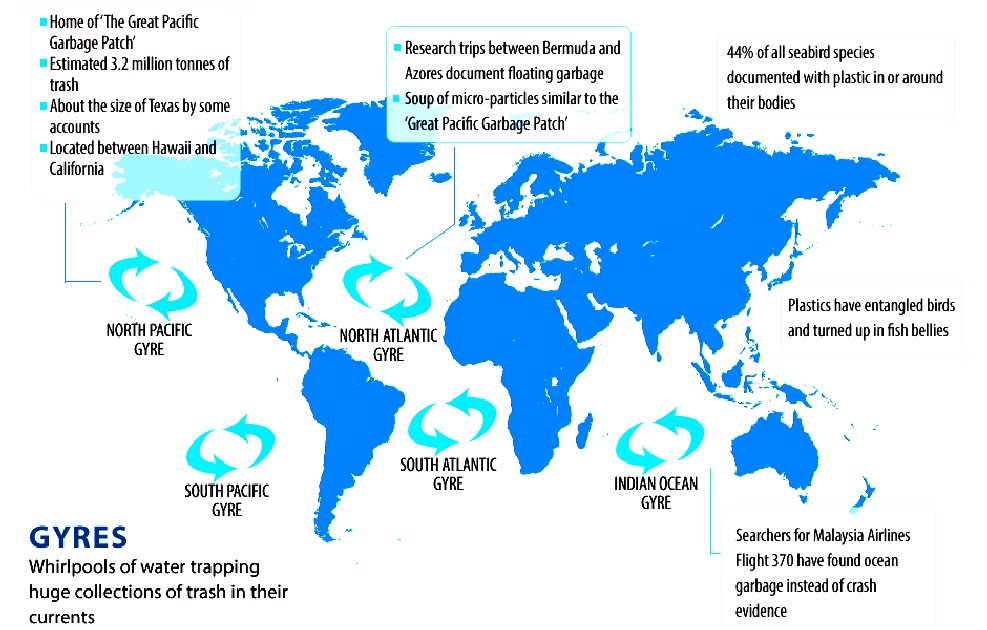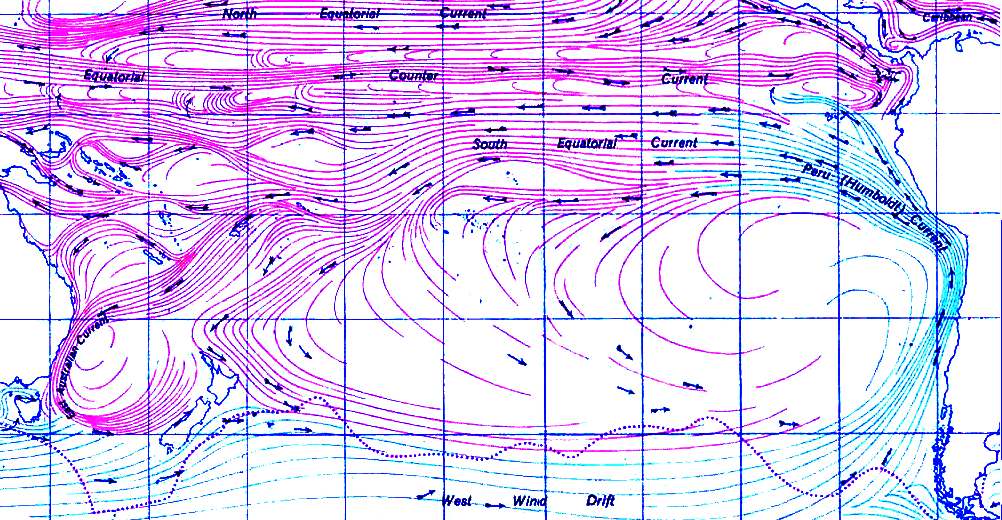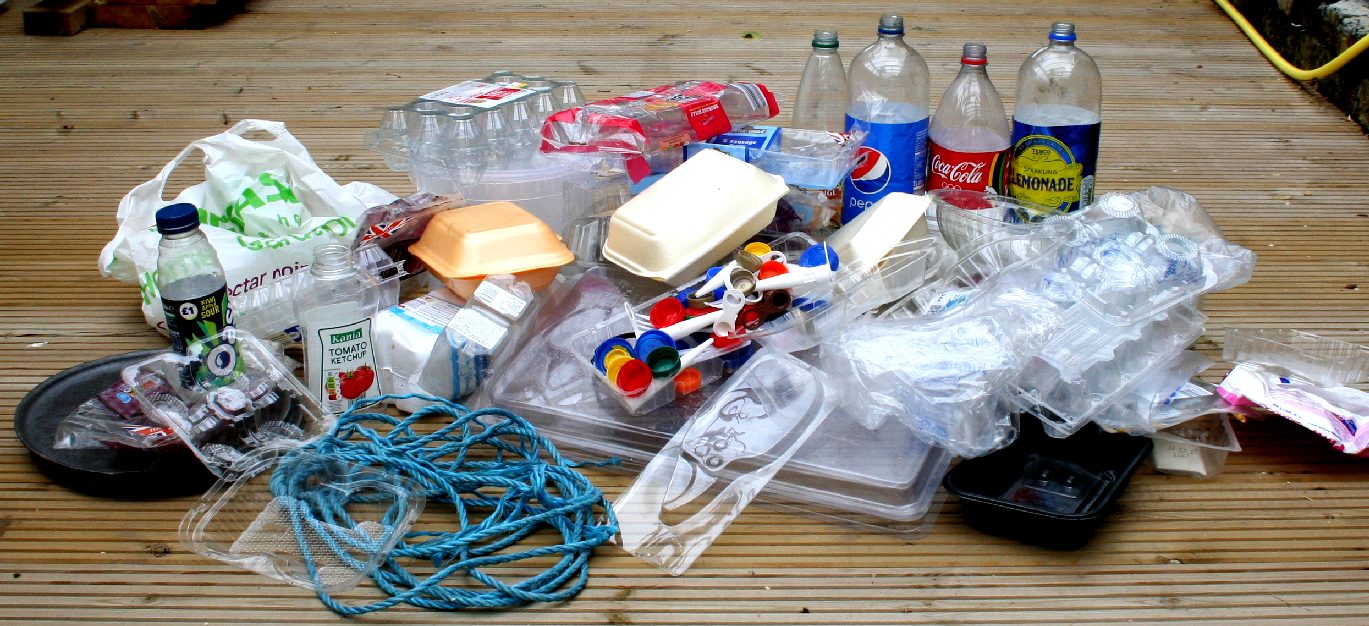|

BUILD
UP
- Plastic has accumulated in five ocean hot spots called
gyres, seen here in this world map derived from information
published by 5 Gyres.
The movement of the world’s major ocean gyres helps drive the “ocean conveyor belt.” The ocean conveyor belt circulates ocean water around the entire
planet, making this an international problem.
There
are 5 swirling ocean garbage patches called
gyres.
Garbage patches generally accumulate far from any country’s coastline, and it is nearly impossible to track the origin of marine debris. The tiny plastic particles that make up most of the patches are also very difficult and expensive to detect and remove.
1.
North Atlantic Gyre 2.
South Atlantic Gyre 3.
Indian Ocean Gyre 4.
North Pacific Gyre 5.
South Pacific Gyre
To date no nation has accepted responsibility for cleaning up the ocean’s garbage
patches to the extent that they will agree to fund ocean cleaning up operations.
Such Agreement could allow a commercial approach to venture capitalists.
On
land, the G20 have agreed to work to reduce single use plastic
in the hope
of slowing build up in the ocean, unfortunately, leaving the plastic in our
oceans to alter marine ecology, kill seabirds, contaminate fish
and kill marine mammals.
The
G7
have created a fund for academics and innovation competitions looking for
ways to tackle ocean plastic waste. The Cleaner
Ocean Foundation does not qualify for such funding where these baits
assume corporate trading and profits from which to carve an R&D budget,
leaving SeaVax
and RiverVax
development out in the cold as a not for profit organization with charitable
objects.
The
Foundation does not qualify for registration according to the UK Charity
Commission, despite acknowledgement of societal good works. This leaves donations
and crowdfunding
as our last realistic hope.

PROTESTS
- One way of drawing attention
to a social problem like marine litter is to peacefully demonstrate with
signs like this that say it all. By keeping the subject live in the minds of
politicians, eventually they will be forced into acting responsibly.
ABOUT
THE SPG
The Southern Pacific Gyre is part of the Earth’s system of rotating ocean currents, bounded by the Equator to the north, Australia to the west, the Antarctic Circumpolar Current to the south, and South America to the east. The center of the South Pacific Gyre is the oceanic pole of inaccessibility, the site on Earth farthest from any continents and productive ocean regions and is regarded as Earth’s largest oceanic desert. The gyre, as with Earth's other four gyres, contains an area with elevated concentrations of pelagic plastics, chemical sludge, and other debris known as the South Pacific garbage patch.
SEDIMENTATION ACCUMULATIONS
Earth’s trade winds and Coriolis force cause ocean currents in the South Pacific Ocean to circulate counter clockwise. The currents act to isolate the center of the gyre from nutrient upwelling and few nutrients are transported there by the wind (eolian processes) because there is relatively little land in the Southern Hemisphere to supply dust to the prevailing winds. The low levels of nutrients in the region result in extremely low primary productivity in the ocean surface and subsequently very low flux of organic material settling to the ocean floor as marine snow. The low levels of biogenic and eolian deposition cause sediments to accumulate on the ocean floor very slowly. In the center of the South Pacific Gyre, the sedimentation rate is 0.1 to 1 m (0.3 to 3.3 ft) per million years. The sediment thickness (from basement basalts to the seafloor) ranges from 1 to 70m, with thinner sediments occurring closer to the center of the Gyre. The low flux of particles to the South Pacific Gyre cause the water there to be the clearest seawater in the world.
SUBSEA FLOOR BIOSPHERE
Beneath the seafloor, the marine sediments and surrounding porewaters contain an unusual subseafloor biosphere. Despite extremely low amounts of buried organic material, microbes live throughout the entire sediment column. Average cell abundances and net rates of respiration are a few orders of magnitude lower than any other subseafloor biosphere previously studied.
The South Pacific Gyre subseafloor community is also unusual because it contains oxygen throughout the entire sediment column. In other subseafloor biospheres, microbial respiration will break down organic material and consume all the
oxygen near the seafloor leaving the deeper portions of the sediment column anoxic. However, in the South Pacific Gyre the low levels of organic material, the low rates of respiration, and the thin sediments allow the porewater to be oxygenated throughout the entire sediment column.

Radiolytic H2: A Benthic Energy Source
Benthic microbes in organic-poor sediments in oligotrophic oceanic regions, such as the South Pacific Gyre, are hypothesized to metabolize radiolytic hydrogen (H2) as a primary energy source.
The oceanic regions within the South Pacific Gyre (SPG), and other subtropical gyres, are characterized by low primary productivity in the surface ocean; i.e. they are oligotrophic. The center of the SPG is the furthest oceanic province from a continent and contains the clearest ocean water on Earth with ≥ 0.14 mg chlorophyll a per m3. Carbon exported to the underlying deep ocean sediments via the biological pump is limited in the SPG, resulting in sedimentation rates that are orders of magnitude lower than in productive zones, e.g. continental margins.
Typically, deep-ocean benthic microbial life utilizes the organic carbon exported from surface waters. In oligotrophic regions where sediments are poor in organic material, subsurface benthic life exploits other primary energy sources, such as molecular hydrogen (H2).
Radiolysis of Interstitial Water
Radiogenic decay of naturally occurring Uranium (238U and 235U), Thorium (232Th), and Potassium (40K) in seafloor sediments collectively bombard the interstitial water with α, β, and γ particles. The irradiation ionizes and breaks apart water molecules, eventually yielding H2. The products of this reaction are aqueous electrons (e−aq), hydrogen radicals (H·), protons (H+), and hydroxyl radicals (OH·). The radicals are highly reactive, therefore short-lived, and recombine to produce hydrogen peroxide (H2 O2), and molecular hydrogen (H2).
The amount of radiolytic H2 production in seafloor sediments is dependent on the quantities of radioactive isotopes present, sediment porosity, and grain size. These criteria indicate that certain sediment types, such as abyssal clays and siliceous oozes, may have higher radiolytic H2 production relative to other seafloor
strata. Also, radiolytic H2 production has been measured in seawater intrusions into subseafloor basement basalts.
Microbial Activity
The microbes best suited to utilize radiolytic H2 are the knallgas bacteria, lithoautotrophes, that obtain energy by oxidizing molecular
hydrogen via the knallgas reaction:
H2 (aq) + 0.5O2 (aq) H2O (l)
In the surface layer of sediment cores from oligotrophic regions of the SPG, O2 is the primary electron acceptor used in microbial metabolisms. The O2 concentrations decline slightly in surface sediment (initial few decimeters) and are unchanged to depth. Meanwhile, nitrate concentrations slightly increase downward or remain constant in sediment column at approximately the same concentrations as the deep water above the seafloor. Measured negative fluxes of O2 in the surface layer demonstrate that a relatively low abundance of aerobic microbes that are oxidizing the minimally deposited organic matter from the ocean above. Extremely low cell counts corroborate that microbes exist in small quantities in these surface sediments. In contrast, a sediment cores outside of the SPG show rapid elimination of O2 and nitrate at 1 meter below sea floor (mbsf) and 2.5 mbsf, respectively. This is evidence of much higher microbial activity, both aerobic and anaerobic.
The production of radiolytic H2 (electron donor) is stoichiometrically balanced with production of 0.5 O2 (electron acceptor), therefore a measurable flux in O2 is not expected in the substrate if both radiolysis of water and knallgas bacteria co-occur. So, despite the known occurrence of radiolytic H2 production, molecular hydrogen is below the detectable limit in the SPG cores, leading to the hypothesis that H2 is the primary energy source in low-organic seafloor sediments below the surface layer.
Water color
Satellite data images show that some areas in the gyre are greener than the surrounding clear blue water, which is frequently interpreted as areas with higher concentrations of living phytoplankton. However, the assumption that greener ocean water always contains more
phytoplankton is not always true. Even though the South Pacific Gyre contains these patches of green
water, it has very little organism growth. Instead, some studies hypothesize that these green patches are a result of the accumulated waste of marine life. The optical properties of the South Pacific Gyre remain largely unexplored.

FAST
FOOD
-
It's not just fast food, it
is our exploitative society that is poisoning the planet, without thought
for the consequences. We've been living at artificially low prices at the
expense of killing other life on earth.
|



